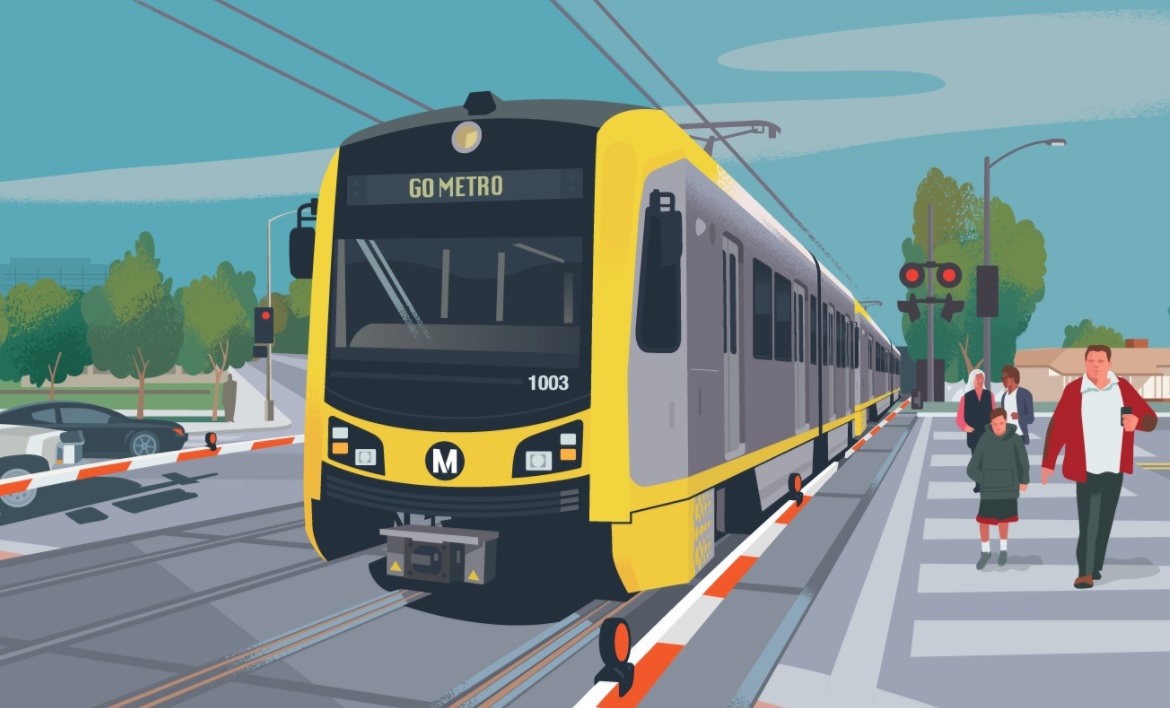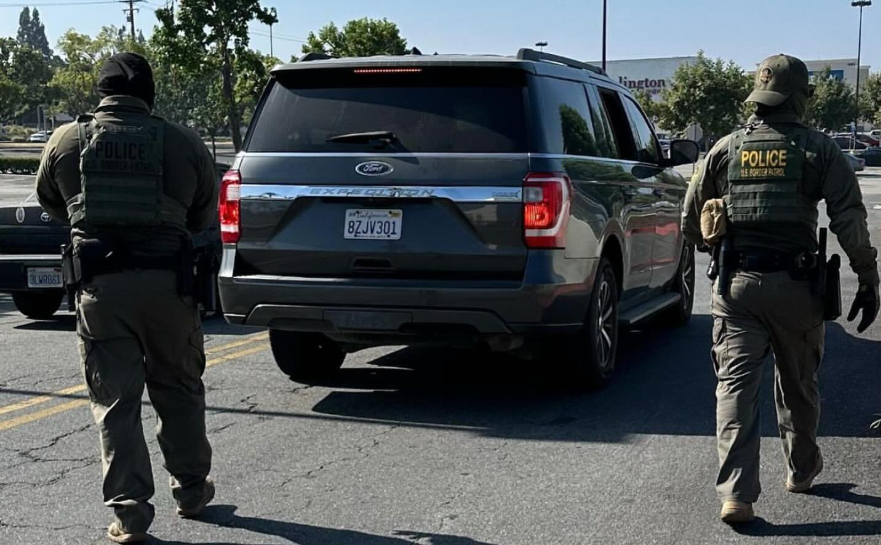Later this month, Metro's board is expected to approve recommended alignment/s for the agency's planned and funded West Santa Ana Branch light rail line. Narrowing down just how the line connects with downtown L.A. is a complicated balancing act.
The West Santa Ana Branch is the name of a currently unused Pacific Electric streetcar right-of-way which extends from the southeast L.A. County city of Paramount to the city of Artesia, and extends farther into Orange County. Metro's planned West Santa Ana Branch Transit Corridor project is a roughly 20-mile light rail line on the historic south county WSAB and connecting into downtown Los Angeles. The project is described in three sections - from south to north:
- Lower - West Santa Ana Branch right-of-way - from Cerritos to Paramount
- Middle - San Pedro Branch right-of-way - from Paramount to Huntington Park
- Upper - several potential alignments (see below) including some sharing of the Metro Blue Line right-of-way - from Huntington Park to downtown L.A.
The rail project has funding in Metro's Measures R and M, though the Measure M expenditure plan has the line in two phases opening in 2028 and 2041. Those dates could move up a bit sooner, under several Metro initiatives: Operation Shovel Ready, the 28-by-28 push for Olympics project acceleration, and a possible public-private partnership with details not yet publicly available. The project recently received additional funds from the state Transit and Intercity Rail Capital Program.
The multi-million dollar question is just how the WSAB line would get into downtown Los Angeles.
Last year Metro announced it was studying four proposed alignments (now called alternatives A-D) to connect the WSAB to Union Station. The two most useful of these early alignments (C,D) share portions of the Metro Blue Line, where the WSAB would run aerially above the Blue Line and connect at transfer stations at Slauson, Vernon, and Washington. Directly between Washington Station and Union Station is the community of Little Tokyo.
Downtown L.A.'s Little Toyko is among the most walkable areas in Southern California. The neighborhood is already well-served by Metro rail and bus lines.
Little Tokyo is also a community that has historically faced plenty of obstacles, many from well-meaning government agencies. The community never entirely recovered from wholesale racist interment during World War II. It weathered urban disinvestment and "renewal" in successive decades. It is currently experiencing the lows and highs of downtown's revitalization: displacement, gentrification, loss of character, accompanied by some new investment and development.
For more than a decade, Little Tokyo has also hosted Metro rail construction, for the Gold Line earlier and now the under-construction Regional Connector subway. The area's leaders bristle at impacts of Metro construction; this conflict has resulted in Little Tokyo legal action against Metro. In the past year, Little Tokyo leaders have expressed concerns over the WSAB, primarily in that construction would further adversely impact their community.
![Four alignments proposed to connect the West Santa Ana Branch rail line into downtown L.A. Map via Metro [PDF]](https://lede-admin.la.streetsblog.org/wp-content/uploads/sites/50/2018/05/WSABnorthernalignments2018updated.jpg?w=663)
Responding to Little Tokyo concerns, earlier this year Metro added four new alternatives (E-H) to connect WSAB rail through DTLA. There are now eight alternatives under consideration. One alignment (E) tunnels under Little Tokyo potentially avoiding some surface construction, though likely not avoiding construction enough to win the support of the Little Tokyo community. Another alignment (F) veers east, avoiding the main Little Tokyo commercial district, but still impacting the community's sites east of Alameda Street. Two alignments (G and H) would bypass Little Tokyo entirely.
Here are the proposed WSAB alignments, with Metro's estimates for ridership, travel time, and cost:
- A - Pacific/Alameda - 58,000 boardings, 36.6 minutes, $4.7B
- B - Pacific/Vignes - 56,000 boardings, 34.5 minutes, $4.7B
- C - Alameda aerial - 75,500 boardings, 35.5 minutes, $4.6B
- D - Alameda/Vignes - 69,500 boardings, 35.5 minutes, $5.0B
- E - Alameda underground - 81,500 boardings, 33.5 minutes, $5.8B
- F - Alameda/Center - 74,500 boardings, 34.0 minutes, $5.4B
- G - Downtown transit core - 78,500 boardings, 33.6 minutes, $5.8B
- H - Arts District/6th Street - 46,500 boardings, 37.5 minutes, $4.5B
From a pure user convenience perspective, a direct WSAB subway running under Alameda Street (alignment E) would make the fastest connection into Union Station. Any alignment through Little Tokyo would likely face community opposition, hence possible legal challenges.
Taking the line under Alameda or connecting into the downtown core (alignments E and G respectively) are the most expensive options, both with a rough order-of-magnitude cost estimate of $5.8 billion. Alternative G would connect to either the Pershing Square or 7th Street station on the Red/Purple Line.
From a cost perspective, ending the WSAB in the Arts District (alignment H) pencils out as the cheapest alternative. To get to Union Station (or nearly anywhere), WSAB riders would have to transfer to a future extension of the Metro Red/Purple Line. DTLA Arts District interests are likely to be supportive of this alternative, as it means that their proposed but not-quite-funded station would finally get built. Little Tokyo leaders would likely support it too. Opposition to alternative H could come from Southeast L.A. County residents who would face a less useful and less convenient rail line due to needing to transfer to get to useful destinations outside the Arts District. Riders would need to transfer twice to get onto the Eastside Gold Line or Expo Line. The less-than-optimal rider utility is reflected in Metro estimates projecting the longest travel time and lowest ridership.
Metro is in the middle of a series of community meetings to get input on all of the proposed WSAB alternatives. The final community meeting of this round will take place from 6-8 p.m. this Thursday, May 3 at the Progress Park-West Community Center at 15500 Downey Avenue in the city of Paramount. Metro is taking public comment at that meeting, as well via an online comment form. Comments can be emailed to wsab[at]metro.net. The deadline for the latest round of public input is this Thursday May 3.
Metro staff anticipate narrowing the current eight alignments down to a "more reasonable number" to be approved by the Metro board at its May 24 monthly meeting. These alignments would be further studied via the environmental clearance process, with a final alignment approved by the board in 2021.
(Updated 5/2 - Changed the word "preferred" to "recommended" as the word preferred tends to mean the final selected route at the end of the environmental processes - ie: the "locally preferred alternative." Metro is currently narrowing down choices; the final preferred route won't be decided for a couple years.)







